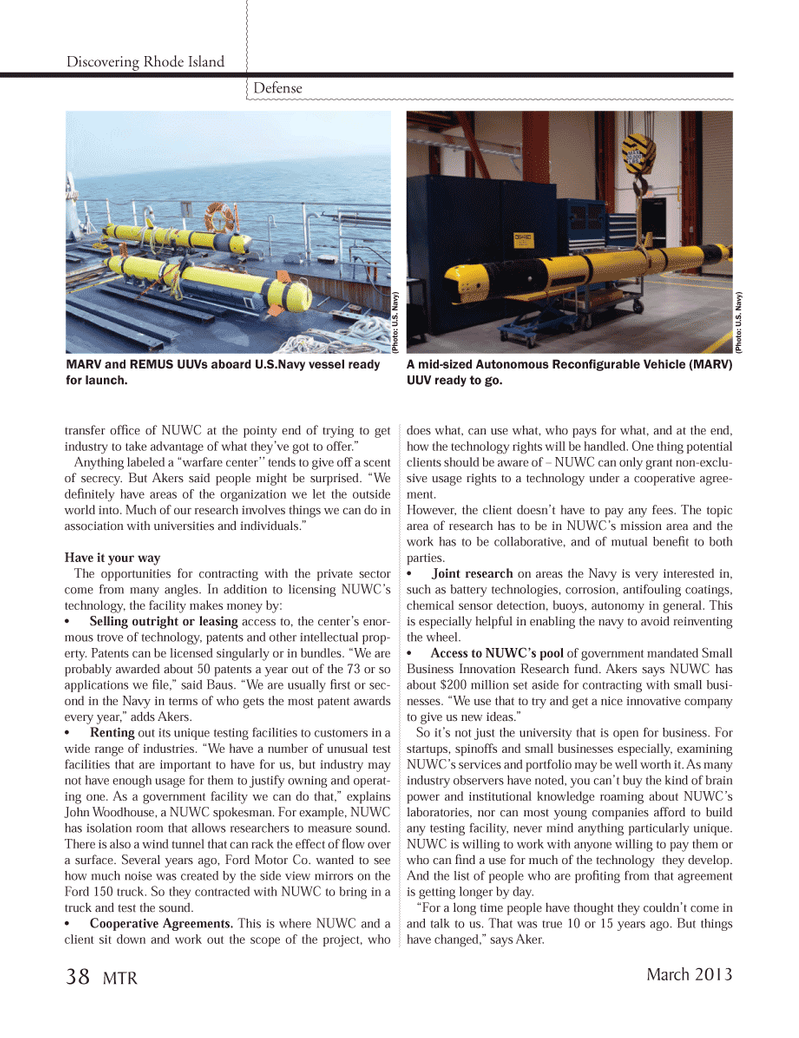
Page 38: of Marine Technology Magazine (March 2013)
Instrumentation: Measurement, Processing & Analysis
Read this page in Pdf, Flash or Html5 edition of March 2013 Marine Technology Magazine
Discovering Rhode Island Defense transfer ofÞ ce of NUWC at the pointy end of trying to get industry to take advantage of what theyÕve got to offer.Ó Anything labeled a Òwarfare centerÕÕ tends to give off a scent of secrecy. But Akers said people might be surprised. ÒWe deÞ nitely have areas of the organization we let the outside world into. Much of our research involves things we can do in association with universities and individuals.Ó Have it your way The opportunities for contracting with the private sector come from many angles. In addition to licensing NUWCÕs technology, the facility makes money by: Selling outright or leasing access to, the centerÕs enor- mous trove of technology, patents and other intellectual prop- erty. Patents can be licensed singularly or in bundles. ÒWe are probably awarded about 50 patents a year out of the 73 or so applications we Þ le,Ó said Baus. ÒWe are usually Þ rst or sec- ond in the Navy in terms of who gets the most patent awards every year,Ó adds Akers. Renting out its unique testing facilities to customers in a wide range of industries. ÒWe have a number of unusual test facilities that are important to have for us, but industry may not have enough usage for them to justify owning and operat- ing one. As a government facility we can do that,Ó explains John Woodhouse, a NUWC spokesman. For example, NUWC has isolation room that allows researchers to measure sound. There is also a wind tunnel that can rack the effect of ß ow over a surface. Several years ago, Ford Motor Co. wanted to see how much noise was created by the side view mirrors on the Ford 150 truck. So they contracted with NUWC to bring in a truck and test the sound. Cooperative Agreements. This is where NUWC and a client sit down and work out the scope of the project, who does what, can use what, who pays for what, and at the end, how the technology rights will be handled. One thing potential clients should be aware of Ð NUWC can only grant non-exclu- sive usage rights to a technology under a cooperative agree- ment. However, the client doesnÕt have to pay any fees. The topic area of research has to be in NUWCÕs mission area and the work has to be collaborative, and of mutual beneÞ t to both parties. Joint research on areas the Navy is very interested in, such as battery technologies, corrosion, antifouling coatings, chemical sensor detection, buoys, autonomy in general. This is especially helpful in enabling the navy to avoid reinventing the wheel. Access to NUWC?s pool of government mandated Small Business Innovation Research fund. Akers says NUWC has about $200 million set aside for contracting with small busi- nesses. ÒWe use that to try and get a nice innovative company to give us new ideas.Ó So itÕs not just the university that is open for business. For startups, spinoffs and small businesses especially, examining NUWCÕs services and portfolio may be well worth it. As many industry observers have noted, you canÕt buy the kind of brain power and institutional knowledge roaming about NUWCÕs laboratories, nor can most young companies afford to build any testing facility, never mind anything particularly unique. NUWC is willing to work with anyone willing to pay them or who can Þ nd a use for much of the technology they develop. And the list of people who are proÞ ting from that agreement is getting longer by day. ÒFor a long time people have thought they couldnÕt come in and talk to us. That was true 10 or 15 years ago. But things have changed,Ó says Aker. MARV and REMUS UUVs aboard U.S.Navy vessel ready for launch. A mid-sized Autonomous Recon Þ gurable Vehicle (MARV) UUV ready to go. (Photo: U.S. Navy) (Photo: U.S. Navy) March 2013 38 MTRMTR #2 (34-49).indd 38MTR #2 (34-49).indd 383/6/2013 2:52:13 PM3/6/2013 2:52:13 PM

 37
37

 39
39
